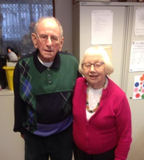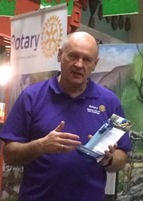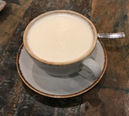February 100 Club
This month’s prize numbers were drawn by member Peter Rosser and the lucky winners are:-
No. 15 Lyn Bearcroft £20
No. 49 Greg York £10
If you would like to join our 100 club and be in with a chance of winning, it costs just £1 a month. Ask at the museum for further details.
Diamond Anniversary
 Congratulations to long-standing
members and
supporters, Denis
and Audrey
Osland
who celebrated
their
60th (Diamond)
Wedding
Anniversary on 6th February!
Congratulations to long-standing
members and
supporters, Denis
and Audrey
Osland
who celebrated
their
60th (Diamond)
Wedding
Anniversary on 6th February!
Rotary Club
 Members of Abertillery and Blaina Rotary Club gave a presentation at the Museum's February coffee morning. The Rotary Club originated in Chicago and acquired its name from the fact that the venue for meetings rotated among members. The organisation spread around the world and the Abertillery Club was formed in July 1938 - in the Market Hall which now houses our museum. The founder members will be familiar to those of a certain age - Tom Evans (jeweller), Mr Ralph (Ralph buses), Mr Barrell (wholesale fruiterer) - to name just a few. You will see they were all men but the organisation works on a more informal basis now and welcomes women members. The work carried out by Abertillery and Blaina Rotary Club is truly inspirational, helping the local community as well as being involved in projects around the world. One project in which they are involved locally is 'Period Equity' - a scheme to provide free sanitary products to those who need them. Thanks to Rotary, the museum now has a box of sanitary items in our toilets. The sanitary products are free to those who need them and if anyone would like to donate items then that would be appreciated. The many projects Rotary supports are too numerous to mention here but long may they continue. Well done Rotary and keep up the good work!
Members of Abertillery and Blaina Rotary Club gave a presentation at the Museum's February coffee morning. The Rotary Club originated in Chicago and acquired its name from the fact that the venue for meetings rotated among members. The organisation spread around the world and the Abertillery Club was formed in July 1938 - in the Market Hall which now houses our museum. The founder members will be familiar to those of a certain age - Tom Evans (jeweller), Mr Ralph (Ralph buses), Mr Barrell (wholesale fruiterer) - to name just a few. You will see they were all men but the organisation works on a more informal basis now and welcomes women members. The work carried out by Abertillery and Blaina Rotary Club is truly inspirational, helping the local community as well as being involved in projects around the world. One project in which they are involved locally is 'Period Equity' - a scheme to provide free sanitary products to those who need them. Thanks to Rotary, the museum now has a box of sanitary items in our toilets. The sanitary products are free to those who need them and if anyone would like to donate items then that would be appreciated. The many projects Rotary supports are too numerous to mention here but long may they continue. Well done Rotary and keep up the good work!
A History of coffee
 Let’s have a coffee! What will it be? Flat white; cappuccino; latte; espresso; filter; americanco or will it be just a plain old teaspoon of instant? Granules or powder? The choice is endless.
Let’s have a coffee! What will it be? Flat white; cappuccino; latte; espresso; filter; americanco or will it be just a plain old teaspoon of instant? Granules or powder? The choice is endless.
Where did coffee come from? Where did it all begin? There are many legends about the origin of coffee.
Coffee grown worldwide can trace its heritage back centuries to the ancient coffee forests of Ethiopia. There, legend says the goat herder Kaldi first discovered the potential of these beloved beans.
The story goes that Kaldi discovered coffee after he noticed that after eating the berries from a certain tree, his goats became so energetic that they did not want to sleep at night.
Kaldi reported his findings to the abbot of the local monastery, who made a drink with the berries and found that it kept him alert through the long hours of evening prayer. The abbot shared his discovery with the other monks at the monastery, and knowledge of the energizing berries began to spread.
As word moved east and coffee reached the Arabian peninsula, it began a journey which would bring these beans across the globe.
European travellers to the Near East brought back stories of an unusual dark black beverage. By the 17th century, coffee had made its way to Europe and was becoming popular across the continent.
When coffee arrived in Europe in the 16th century, clergymen pressed for it to be banned and labelled Satanic. But Pope Clement VIII took a taste, declared it delicious, and even quipped that it should be baptised. On the strength of this papal blessing, coffee houses rapidly sprang up throughout Europe.
Despite such controversy, coffee houses were quickly becoming places to socialise, in the major cities of England, Austria, France, Germany and Holland. In England “penny universities” sprang up, so called because for the price of a penny one could purchase a cup of coffee and engage in stimulating conversation.
By the mid-17th century, there were over 300 coffee houses in London, many of which attracted like-minded people, including merchants, shippers, brokers and artists.
After crude oil, coffee is the most sort after commodity in the world.
We’ve all no doubt got our favourite type of coffee though Espresso is probably the most popular type of coffee. Did you know, it takes 50 coffee beans to make 1 shot of espresso.
Also have you ever heard of ‘egg coffee’? Egg coffee originated in 1946 in Vietnam, following a shortage of milk. Made with strong espresso, beaten egg yolks and condensed milk it’s like drinking a sweet, thick crème brûlée. Not too sure if I fancy it, though I’ve been told it’s delicious by someone who’s tried it.
Recently I stayed with relatives who had one of those ‘state of the art’ coffee making machines. It’s gleaming presence took pride of place on the kitchen worktop. If a cup of coffee was being brewed it made a deafening noise rather like a large jet plane taking off! First the machine ground the fresh coffee beans; the resulting powder then had to be shaken out and carefully pushed down into a holder using a special implement for the task; then there seemed to be much steaming, bubbling and frothing with extra attachments being pushed on, screwed on and placed on, with much dial turning and general palaver! Maybe I’m just old fashioned but I have to admit this machine was quite beyond me! It did look pretty modern and sleek though!
Maybe tea would be a better bet.......now.......which to have? Black tea; green tea; fruit tea; peppermint tea.......but maybe that’s another story!
Katherine Taylor
Thankyou
Many thanks to Jen Price and Katherine Taylor once more for their contributions to this newsletter (above and page 3 for their latest contributions). Without their help I would struggle to fill it each month. If any other readers have a story to tell please email me at sallymurphy@talktalk.net or post it to me at the museum.
SNOWDROPS
Some friends and I visited the Rococo Garden at Painswick in the Cotswolds, in early February. The garden is at its best then if you want to see the snowdrops – millions of them. They look so delicate but must be as tough as old boots to push up through the hard, often frozen, winter ground to show themselves to the world. Seeing them prompted me to find out a bit more about them.
I was surprised to learn that they are not native to Britain but come originally from eastern Europe and south west Asia although they are now found widely around the world and naturalise well in the right conditions. No-one is quite sure when they were introduced to Britain but the first reference to snowdrops in our gardens dates back to 1597. It was not until 1754 that the common or 'Garden Snowdrop' that we know so well was given its formal botanical name of Galanthus nivalus which translates as 'milk flower of the snow'. When you stop and think about it, 'snowdrop' is a truly delightful name for a beautiful little flower which is even more beautiful when you turn up its bell head to look inside.
A number of myths have grown up around the snowdrop. In Victorian times swathes of snowdrops were planted in and around graveyards and this may be why the flowers came to be thought of, in many areas, as harbingers of doom and death if cut and brought indoors. A more down to earth explanation may be that the bulb, in particular, is poisonous. On a more cheerful note, many regard the snowdrop as symbolic of hope, signalling that winter is gradually giving way to spring.
As with so many plants, careful cultivation has given rise to very many different cultivars of snowdrop although the most popular (and one of the cheapest to buy) is still the Garden Snowdrop – Galanthus nivalis. The rarer species demand high price; in 2015 a single snowdrop sold for £1390! Pots with three little snowdrop plants cost about £3.50 at the Rococo Garden and the most expensive variety on sale there cost £15 per pot. The Rococo Garden at Painswick prides itself on its mass displays of snowdrops. Other gardens, such as Colesbourne Garden, also in the Cotswolds, specialise in the variety of snowdrops they cultivate and this particular garden has no less than 300 species. Having looked at its website, Colesbourne Garden is definitely on my list of places to visit.
Remember, if you are growing snowdrops, they are best planted 'in the green' and they don't like to dry out. Once you have a decent clump it can easily be lifted and divided and this is a cheap way of spreading snowdrops around your garden. Who can fail to smile when you see these lovely little flowers, the white flowerheads seeming to shine on even the dullest of days? I already have a few small clumps in the garden but still couldn't resist buying a small pot at Painswick though not the £15 pot!
Jen Price

Snowdrops at Rococo Garden, Painswick
Editor’s comment. Last year an old friend of mine from Abertillery gave me a few bunches of snowdrops from her garden. Shortly after, a combination of age and ill health meant she had to sell her much loved home and move into a care home, albeit a luxury one. I’m pleased to say her snowdrops now live on in my garden.
BE FRAUD AWARE
Last month we looked at Identity theft and identity fraud; this month it is the turn of Rogue Traders. This information comes from Gwent Police’s website.
Rogue Traders
Has anyone ever knocked your door trying to sell you goods or services? Many honest businesses use this technique – but so do fraudsters. Rogue traders often appear to be highly professional. They can have printed leaflets and vehicles branded with their company name, making you think they are legitimate. Don’t be fooled - they are criminals!
They often use highly pressurised selling techniques to convince victims to use their services and they charge exorbitant prices for work of a poor standard or work that is never carried out. We often hear stories about people being convinced that they need work done, for example building work on their home, that doesn’t even need to be done. In the worse cases, we’ve seen rogue traders stealing cash and belongings from the homes of their victims.
How to protect yourself against rogue traders and bogus callers:
• Only use businesses that have been recommended to you by a trusted friend or family member and you can see examples of their work.
• Ask for quotes in writing and then follow up by getting another three quotes from independent traders to check that the price quoted is accurate.
• Get the address of their company. If possible, visit the premises to check that it exists.
• Don’t be fooled by someone who says that they are just working up the street or that they have done work for your neighbour. Some people say this to gain your trust. Ask for specific examples and then follow up to check if what they have said is true.
• If someone calls at your home trying to sell you something, don’t let them in and always ask for ID.
• Many streets in Gwent are now ‘no cold calling zones’. Talk to the Trading Standards Team in your local council for more information. Remember traders must give you written notice of your right to 14 days cancellation when agreeing to do work at your home, including work gained from a cold call.
What should you do if you’ve been a victim?
• Report it to Action Fraud, the national fraud and cyber-crime reporting centre. You can do this on-line by going to www.actionfraud.police.uk/report_fraud or by calling 0300 123 2040.
• You can also report it to the Trading Standards team in your local council.
• Citizens Advice can help by giving you advice on terms and conditions of agreements or contracts you may have signed. You can call the consumer helpline on 03454 04 05 06 or go to www.citizensadvice.org.uk/wales/ for other ways to get in touch.
• If you do go ahead and have work done, always pay with a credit card if possible. Then, if things go wrong, you are protected under Section 75 of the Consumer Credit Act for the entire purchase even if you’ve only paid the deposit on your credit card. If you’ve paid with a debit card for goods or services, it is still worth contacting your card provider/bank and explain that you have been a victim as they may be able to do a ‘chargeback’.
They’ll also be able to give you advice on how to cancel payments and protect your identity from possibly being stolen.
• We’re always here to help. You can call us on 101 or 999 in an emergency. You can also contact Connect Gwent, our victims hub on 0300 123 21 33 or by visiting www.connectgwent.org.uk.
Top Of Page
